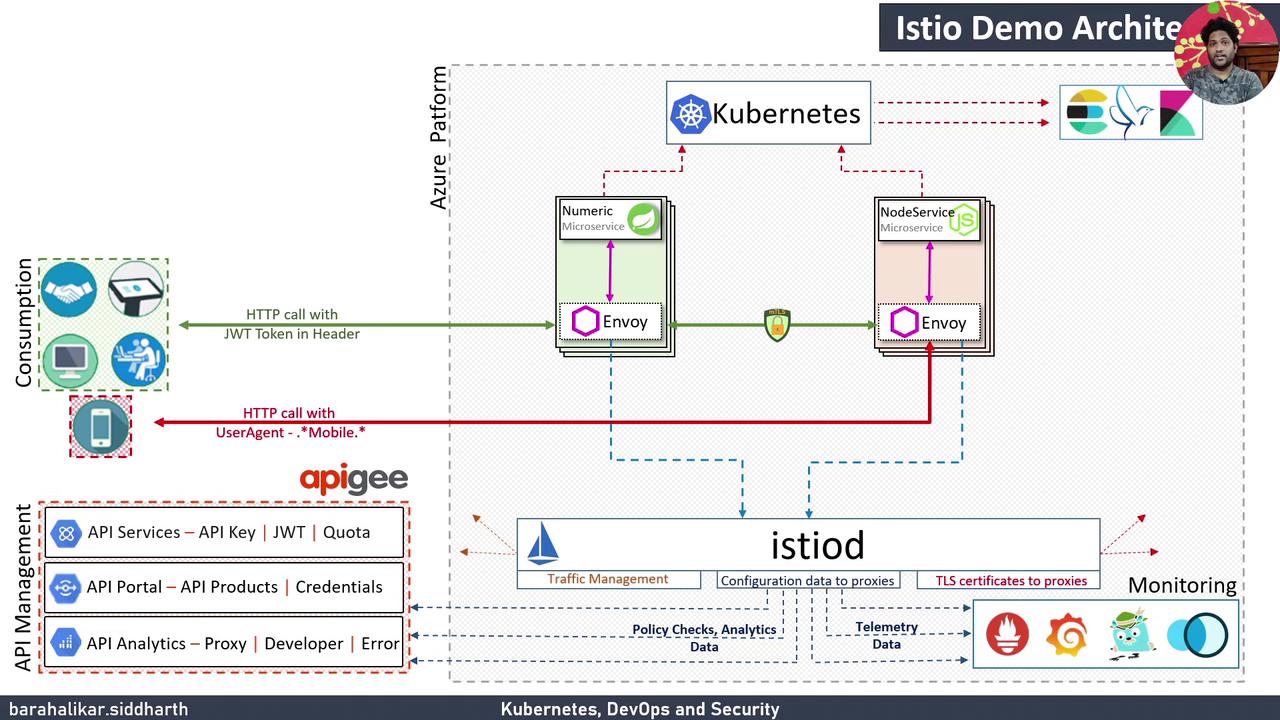DevSecOps - Kubernetes DevOps & Security
Kubernetes Operations and Security
Demo Istio Injecting SideCar Container
Introduction
Istio sidecar injection embeds an Envoy proxy alongside your application container to enable advanced traffic management, mutual TLS, and telemetry within Kubernetes. In this guide, you’ll learn how to:
- Inject an Envoy sidecar into a pod automatically
- Deploy a Node.js microservice in a dedicated namespace
- Verify the injected sidecar and inspect traffic flows
Sidecar proxy is also known as a sidecar container, proxy sidecar, or Envoy sidecar—these terms are used interchangeably.
Sidecar Injection Methods
Istio offers two approaches to inject the Envoy proxy into your workloads:
| Method | Description | Commands |
|---|---|---|
| Automatic Injection | Labels a namespace so that any new pod includes the sidecar via a mutating webhook. | bash<br>kubectl label namespace <name> istio-injection=enabled<br>kubectl apply -f movies.yaml |
| Manual Injection | Injects proxy settings directly into your YAML before applying with istioctl. | bash<br>kubectl apply -f <(istioctl kube-inject -f movies.yaml) |
Note
We’ll use Automatic Injection for this demo, since it requires no modifications to your application manifests.
Istio Demo Architecture

| Component | Role |
|---|---|
| Azure VM Kubernetes Cluster | Hosts Istio control plane (Pilot, Citadel, Galley) and workloads |
| Istio Sidecar (Envoy) | Intercepts pod traffic for routing, mTLS, and telemetry |
| Telemetry & Visualization | Grafana, Prometheus, Kiali, Jaeger capture metrics and traces |
| API Management (Optional) | Apigee integration for API security, developer portals, and analytics |
Prerequisites
- A Kubernetes cluster with Istio installed
kubectlandistioctlCLI tools available- Docker image
siddharth67/node-service:v1pushed to a registry
1. Create and Label the prod Namespace
First, set a shorthand for kubectl:
alias k=kubectl
List your namespaces:
k get ns
Create prod and confirm:
k create namespace prod
k get ns
2. Deploy the Node.js Service
Deploy the Node.js microservice with a single container initially:
k -n prod create deployment node-app \
--image=siddharth67/node-service:v1
Expose it as a ClusterIP service on port 5000:
k -n prod expose deployment node-app \
--name=node-service \
--port=5000 \
--target-port=5000 \
--type=ClusterIP
Verify the resources:
k get all -n prod
3. Enable Automatic Sidecar Injection
Inspect existing namespace labels:
kubectl get ns --show-labels
Label prod for Istio:
kubectl label namespace prod istio-injection=enabled
kubectl get ns --show-labels
Note
The istio-system namespace is generally labeled istio-injection=disabled to prevent sidecar injection into control plane components.
4. Restart the Deployment
Trigger pod recreation so the Envoy sidecar is injected:
kubectl -n prod rollout restart deployment node-app
kubectl -n prod rollout status deployment/node-app
Confirm new pods show 2/2 READY:
kubectl get pods -n prod
5. Verify the Sidecar Injection
Inspect one of the pods in detail:
kubectl -n prod describe pod <pod-name>
Under Containers: you should see:
node-service(your application)istio-proxy(Envoy sidecar, e.g.,docker.io/istio/proxyv2:1.9.0)
List pods again:
kubectl -n prod get pods
NAME READY STATUS RESTARTS AGE
node-app-597c464649-lgs82 2/2 Running 0 100s
Next Steps
You can extend this workflow by deploying additional services—such as a Spring Boot app via Jenkins Pipeline—or by customizing traffic routing with Istio VirtualServices and DestinationRules.
Links and References
Watch Video
Watch video content
Practice Lab
Practice lab